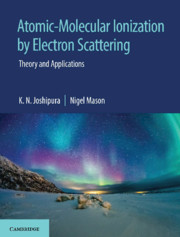Book contents
- Frontmatter
- Dedication
- Contents
- List of Figures
- List of Tables
- Foreword I
- Foreword II
- Preface
- Acknowledgments
- 1 Atoms and Molecules as Bound Quantum Systems
- 2 Quantum Scattering Theories
- 3 Electron Atom Scattering and Ionization
- 4 Electron Molecule Scattering and Ionization – I: Small Molecules and Radicals
- 5 Electron Molecule Scattering and Ionization – II: Other Polyatomic Molecules and Radicals
- 6 Applications of Electron Scattering
- Bibliography
- Index
Foreword I
Published online by Cambridge University Press: 20 December 2018
- Frontmatter
- Dedication
- Contents
- List of Figures
- List of Tables
- Foreword I
- Foreword II
- Preface
- Acknowledgments
- 1 Atoms and Molecules as Bound Quantum Systems
- 2 Quantum Scattering Theories
- 3 Electron Atom Scattering and Ionization
- 4 Electron Molecule Scattering and Ionization – I: Small Molecules and Radicals
- 5 Electron Molecule Scattering and Ionization – II: Other Polyatomic Molecules and Radicals
- 6 Applications of Electron Scattering
- Bibliography
- Index
Summary
Electron collisions with atoms and molecules are commonplace. In the natural world they occur in lightning strikes, aurorae, and the Earth's ionosphere in general; outside our planet they are important for similar processes in other planets. The glow of Jupiter's aurora can clearly be seen using telescopes from the Earth. Electron collisions also form a primary process in cometary tails that are bathed in the solar wind, and in many other astrophysical processes. Plasma is the fourth state of matter which involves partial ionization of the atomic and molecular components. Plasmas occur naturally in flames, stars, and elsewhere. Humankind has increasingly harnessed the power of electron collisions in many ways: to start cars with spark plugs, in the traditional light bulb, and in many lasers. Much of modern industry is driven by the use of electron collisions to create plasmas which etch silicon and other materials into ever more complex structures or to provide surface coatings to alter, enhance, or protect the properties of materials. The quest to harness the Sun's power on Earth via fusion involves making a vast hot plasma with a wealth of electron collision processes requiring detailed study. In the current century it has also been realized that the damage experienced by bio-systems as a consequence of all types of high energy particles and radiation is predominantly caused by collisions involving secondary electrons. These electrons are created by the ionizing effect of the original high-energy collision particle independent of the nature of the colliding species. In medical applications these collisions can be harmful, causing double strand breaks of DNA, or beneficial as in radiation therapy, which is widely used to exorcize malignant tumours.
Electrons colliding with atoms and particularly molecules can initiate a variety of processes. Probably the most important of these is the creation of ions (charged species) either through impact ionization or by electron attachment leading to positively and negatively charged ions respectively. These ionized species are chemically active and act as initiators of many of the processes mentioned above.
Information
- Type
- Chapter
- Information
- Atomic-Molecular Ionization by Electron ScatteringTheory and Applications, pp. xxiii - xxivPublisher: Cambridge University PressPrint publication year: 2019
